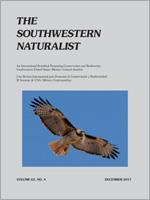We conducted a statewide study, in June and July 2016, of feral colonies and domesticated hives to understand the current and potential impacts of invasive parasites and pests on honey bee (Apis mellifera) populations in Texas. We identify the subspecies for each colony sampled in addition to reporting the presence of parasites. The most common subspecies found were Apis mellifera scutellata, Apis mellifera carnica, and Apis mellifera ligustica. We confirmed the presence of Apis mellifera syriaca and Apis mellifera macedonica in Texas. Varroa destructor and Nosema ceranae were the most common parasites, found in eight and nine ecoregions, respectively. Aethina tumida was found in only 4 of the 10 ecoregions.
How to translate text using browser tools
1 December 2017
Prevalence of honey bee (Apis mellifera) parasites across Texas
Alexandra Herrera,
Autumn Smith-Herron,
Nicole Traub,
Kristina Yount,
Brian R. Chapman
ACCESS THE FULL ARTICLE

The Southwestern Naturalist
Vol. 62 • No. 4
December 2017
Vol. 62 • No. 4
December 2017




